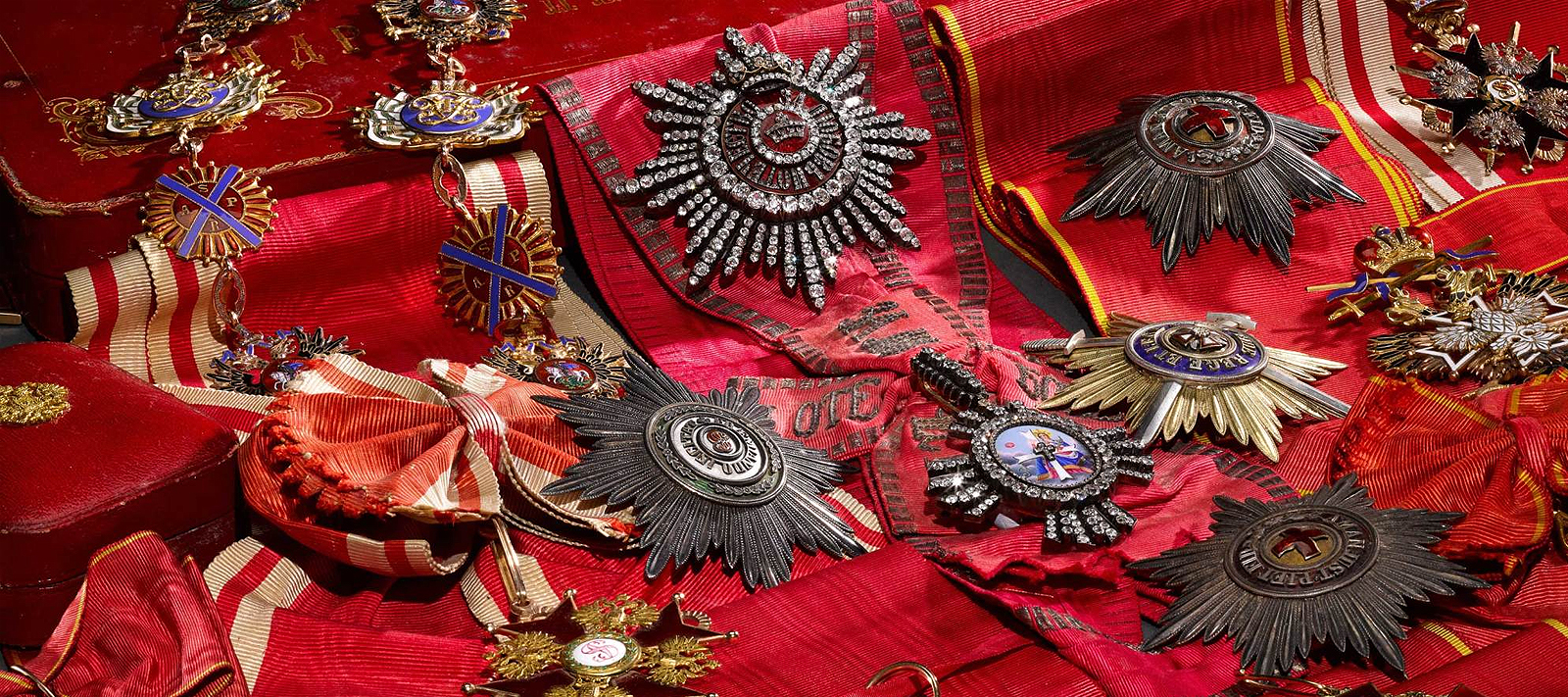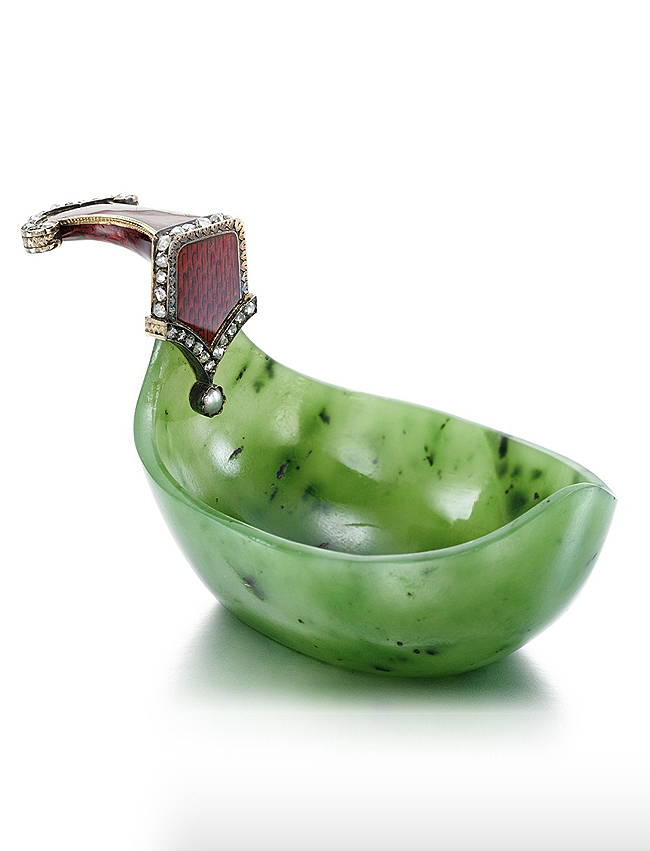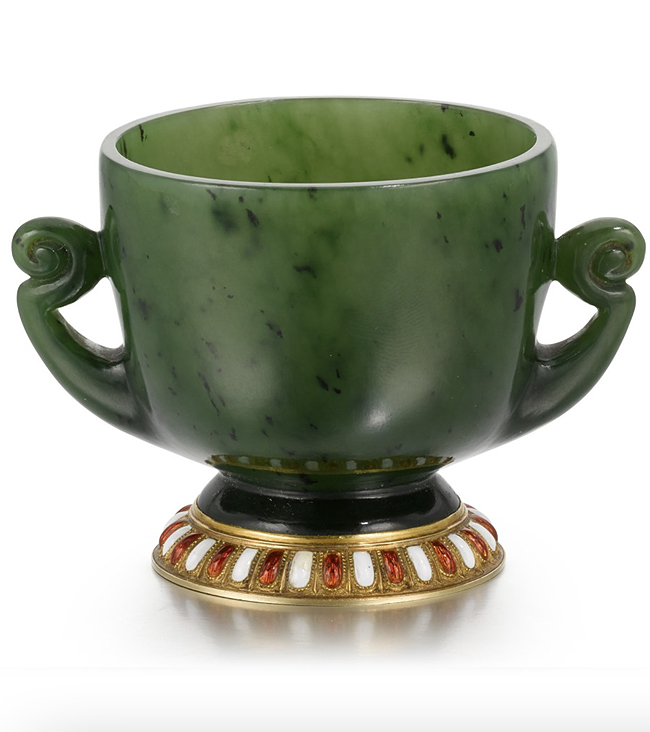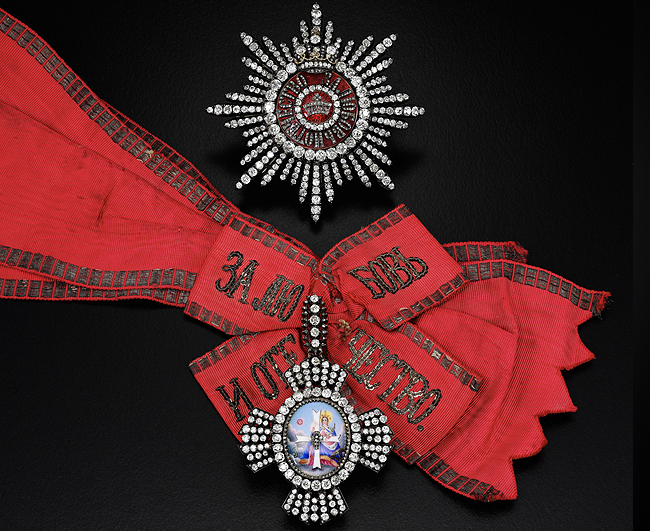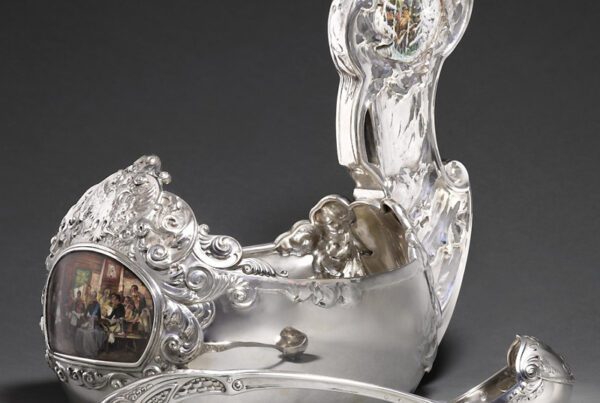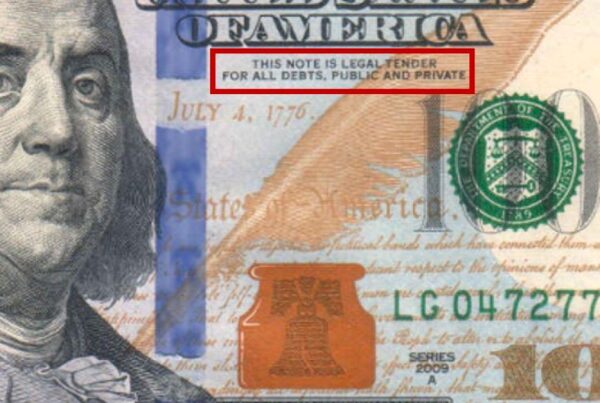This 266-lot sale is generally pretty mundane, with only a smattering of items liable to interest advanced collectors. I’ve not handled any of the pieces yet, so at this stage I am only assuming that they’re kosher and in decent condition.
FABERGÉ ET AL
- Lot 2, A Fabergé varicoloured gold and silver-gilt mounted guilloché enamel photograph frame, Moscow, 1899-1914. Sotheby’s
- Lot 3, A Fabergé miniature jewelled, nephrite and guilloché enamel kovsh, probably St Petersburg, circa 1900. Sotheby’s
The sale kicks off with a couple of nice pieces of Fabergé: a white guilloché enamel octagonal photo frame (Lot 2, est. £40,000-60,000), and a cute nephrite miniature kovsh with a diamond-framed red guilloché enamel handle (Lot 3, est. £18,000-25,000).
Four Fabergé gold cigarette cases are nothing to write home about – but they’re nice. It’s a great shame my friend John Traina, who boasted the largest collection of Russian cigarette cases in the world, is no longer with us to set the bidding alight (Lots 8-12, est. £10,000-25,000).
- Lot 31, A Fabergé gold and silver-gilt mounted guilloché enamel timepiece, Moscow, circa 1895. Sotheby’s
- Lot 13, A Fabergé gold-mounted and guilloché enamel nephrite charka, St Petersburg, 1899-1903. Sotheby’s
I’m intrigued by a small, gold-mounted nephrite Fabergé charka. I don’t want to malign it before I’ve had a look at it – I need to hold it before commending it or not. One thing’s for certain – the handles look dubious (Lot 13, est. £5,000-7,000).
A bevy of 46 miniature Easter Eggs in four different lots, by four different Fabergé workmasters, are of variable quality – some finely cut, some in rough condition (Lots 18-21, est. £5,000-12,000). The only Fabergé clock of the sale, set off by deep purple enamel (Moscow, c.1895), has a very modest reserve (Lot 31, est. £25,000-35,000).
- Lot 48, A Fabergé jewelled agate model of a cat, St Petersburg, circa 1900. Sotheby’s
- Lot 49, A Fabergé agate model of a goose, St Petersburg, circa 1900. Sotheby’s
A white agate Cat with ruby-set eyes looks a bit stiff; in fact its tail shoots out indecently, as stiff as a ramrod. I’ve never seen a cat with a tail that shrinks towards the end – it looks more like the tail of some overfed rat. Provenance notwithstanding – Sotheby’s talk airily about some ‘Canadian Collection’ – I cannot believe this is by Fabergé (Lot 48, est. £12,000-18,000).
The next lot is equally problematic. Sotheby’s call it a Goose, thought its neck is as long as a swan’s. I’m told the official term for the almighty lump on its beak is ‘basal knob,’ but this one looks as if it’s still throbbing from a fight with a fox. The belligerent bird has diamond-set eyes, and Sotheby’s claim its honey-coloured agate is ‘realistically carved.’ Really? The carving to the wings lacks detail, while the feet and tail are clumsily evoked with chunky grooves. The quality of this critter is less than convincing (Lot 49, est. £18,000-25,000).
Both these animal figurines were first sold at Christie’s, and the goose (or swan) has exhibition history. But my enthusiasm for the pair abates every time I look at them. Many years ago, in my declining youth, I naïvely asked Fabergé doyen Kenneth Snowman how to tell a real Fabergé carving from an impostor. Kenneth gave me a fatherly smile and said: ‘Fabergé creatures are so beautifully carved and anatomically accurate that, if you hold a little dog, piggy or snake in your hands, you expect the dog to start barking, the pig to shove its snout in your face and go oink, and the snake to start slithering off across the table.’ I’ve followed this advice ever since, and never deviate from it one iota. And, boy, does it work! Just open your damned eyes!
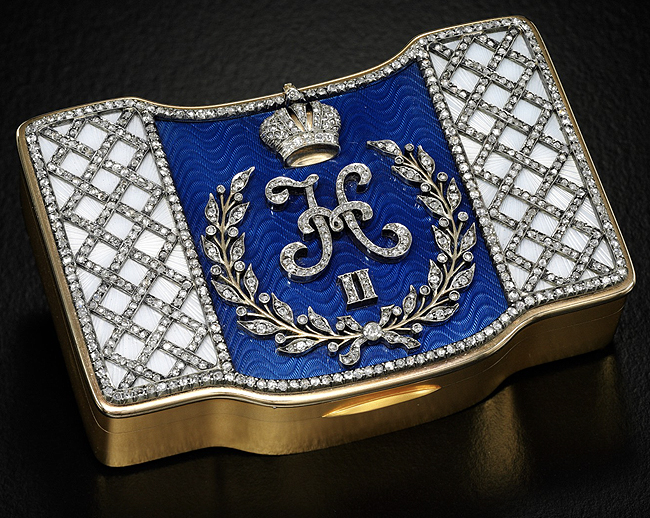
Lot 5, An Imperial Presentation jewelled gold and guilloché enamel snuffbox, workmaster Nikolai Chernokov, Bolin, St Petersburg, 1908-1917. Sotheby’s
Pick of the non-Fabergé objets d’art is a jewelled gold and enamel snuffbox by Bolin (workmaster Nikolai Chernokov) with Nicholas II’s laurel-wreathed cypher picked out in diamonds. The Tsar gave it to the Swedish Minister of Naval Affairs in 1909 (Lot 5, est. £200,000-300,000).
- Lot 6, A gold and enamel Collar of the Order of St Andrew First Called, Keibel, St Petersburg, 1899-1903. Sotheby’s
- Lot 7, A rare diamond-set silver-topped gold-mounted and enamel Order of St Catherine, Grand Cross set of insignia, circa 1890. Sotheby’s
The sale is spangled throughout with a 37-lot Swiss Collection of decorations and orders, whose two late 19th century highlights occur near the beginning: a gold and enamel collar of the Order of St Andrew First Called, by Keibel (Lot 6, est. £80,000-120,000); and a diamond-set Order of St Catherine, Grand Cross formerly in the Sandars Collection (Lot 7, est. £100,000-150,000). Both lots would have demolished those estimates a few years back.
PORCELAIN
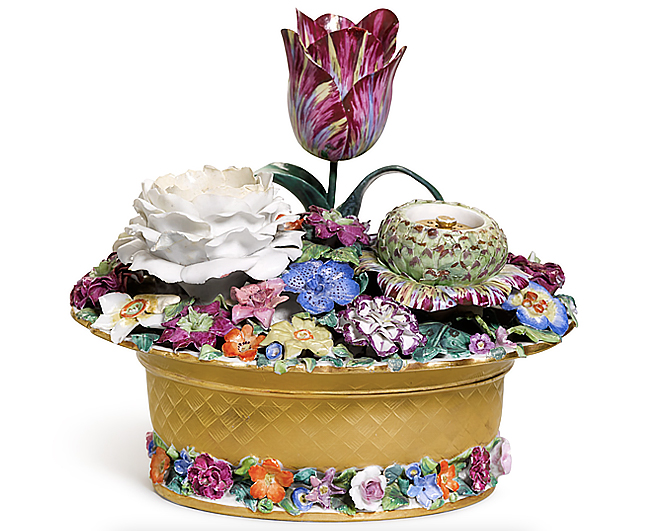
Lot 98, An Imperial presentation porcelain inkwell, Imperial Porcelain Factory, Petr Ivanov, St Petersburg, period of Nicholas I, 1836. Sotheby’s
To my mind the sale’s most interesting piece of porcelain is an Imperial presentation inkwell by Petr Ivanov. It takes the form of a gilded basket ringed by hand-moulded flowers, containing a bevy of blooms in high relief, the highest of which is a perky purple tulip. Sotheby’s provenance suggests that the inkwell was presented to Empress Alexandra Fedorovna as an Easter present in 1836 (Lot 98, est. £30,000-50,000). It’s a shame for this first Alexandra Fedorovna (Mrs. Nicholas I) that Carl Fabergé hadn’t been born yet and appointed purveyor to the court back then, otherwise we’d see a lot more of Fabergé eggs, with little or no scope for forgers. The second Alexandra Fedorovna was much luckier on the egg front.
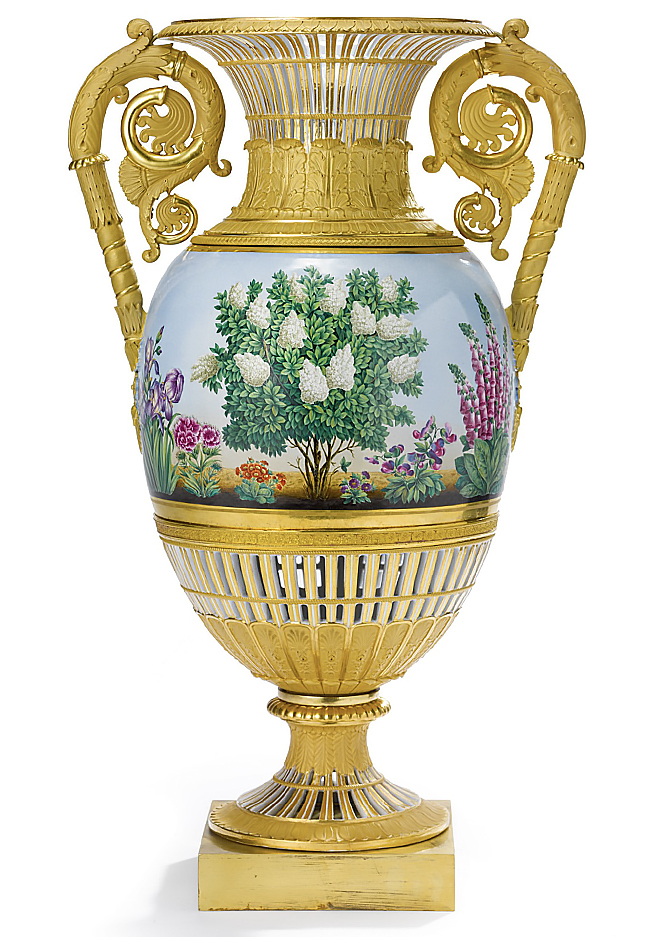
Lot 123, A Russian porcelain vase, Imperial Porcelain Factory, St Petersburg, period of Alexander I. Sotheby’s
I also like a 23-inch Imperial Porcelain Factory vase from the reign of Alexander I (1801-25) – not a period you often see represented at auction when it comes to ceramics. The body is embellished with a broad, continuous frieze of elegantly stylized, vari-coloured flowers including narcissi, carnations and fox-gloves (Lot 123, est. £50,000-70,000). The vase was last seen at Sotheby’s New York in 2013, when it fetched $56,250.
A dozen lots are devoted to the IPM military plates that appear in every sale (Lots 99-110, est. £10,000-35,000). When on earth is the supply going to run out? I used to have a dishwasherful of these myself…thank God I don’t have to look at them any more! Then come a number of items from the St Vladimir Service made by the Gardner Factory in the 1780s, which I have equally little desire to possess.
The sale includes nine lots catalogued as ‘Soviet Propaganda’ porcelain – though some of them have nothing to do with propaganda. Two are plates: one shows an effete seaman by the Neva wearing flared trousers and clutching a yellow posey (Lot 180, est. £12,000-18,000), the other a seated young man reading Pravda to his doe-eyed fiancée (Lot 182, est. £40,000-60,000).
A clutch of 29 Tsarist-era porcelain Easter Eggs – some of them imperial – are shared out among four lots. These used to sell for far more when Harold Whitbeck was yoking together his unhatchable collection in days of yore (Lots 195-198, est. £2,000-3,000).
ENAMELS & ICONS
After a clutch of decanters, baskets, bowls etc. – just auction fillers – we come to nine pieces of cloisonné enamel by Rückert, led by a three-handled cup adorned with swans (Lot 150, est. £70,000-100,000). A couple of cloisonné enamel punch sets have the same, unspecified ‘important family’ provenance: one was made in 1893 by Nikolai Alexeyev (Lot 160, est. £25,000-35,000), the other over a decade later by Grigory Sbitnev (Lot 162, est. £50,000-70,000).
I hate this ‘important family’ nonsense. Who qualifies as important? Who is the judge and attributor of catalogue importance? Does a big bank account make you important? And who falls into the category of ‘less important’? Sotheby’s should explain the rationale behind their use of this asinine expression. For Christ’s sake, am I important? I’ve got some decent bits and bobs in my collection and inventory.
Another catalogue expression I deplore is ‘apparently unmarked.’ What does ‘apparently’ mean? If you can’t see any marks, just say so: not bloody marked. Or write ‘Dear Client, look for yourself!’ Ostensibly, apparently, seemingly, evidently… who needs all this verbal crap?
Back to the sale. Next up: a 30-strong array of icons. Two are by Rückert, several by Ovchinnikov. Most are of solid commercial quality – no more than that.
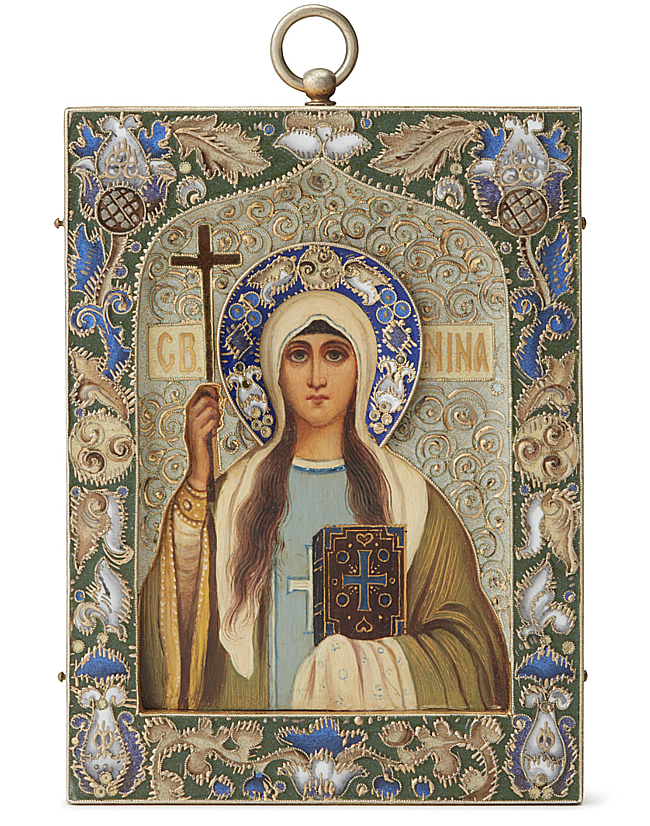
Lot 203, A Fabergé silver-gilt and shaded cloisonné enamel icon of St Nina (Nino) of Georgia, Moscow, 1908-1917. Sotheby’s
The icon that catches my eye, though not for the best reasons, is catalogued as a ‘silver-gilt and shaded cloisonné enamel icon of St Nina (Nino) of Georgia’ and ascribed to Fabergé 1908-17 (Lot 203). The gormless-looking Saint is depicted with lumpen, infantile brushwork. The blue of her halo is not the same shade as the blue in the border; and I don’t particularly like the hallmark (though I need to inspect it personally). The combination of shortcomings makes me wonder just how old this icon can be.
That’s not all. To the left of the saint’s halo is a square containing the Cyrillic letters CB. (short for СВЯТАЯ, i.e. Saint); to the right is a rectangle containing the name NINA, in Latin letters. Why Latin? I don’t remember seeing any Fabergé icons with saints’ names in Latin. Am I missing something? And why does Sotheby’s lot description append the bracketed spelling NINO after NINA? Has their expert been reading Ali & Nino (the Azeri classic wherein Nino is a Georgian Princess)? Also, the square and rectangle are not, as you would expect, the same distance from the border. It’s all way too sloppy for Rückert.
It’s my understanding that the current owner of this icon bought it at the height of the market, for $125,000. Poor guy! I was offered it five years ago for some stupid sum. Sotheby’s want at least £25,000 for it – just £5,000 less than the reserve on the beautiful oval icon with a Rückert oklad being offered at Christie’s. Both are tiny – either side of 4 inches tall – but, in terms of quality, there’s no comparison.
The silver items that follow are decent commercial merchandise. There’s no point commenting on the handful of bronzes that conclude proceedings (Lots 260-266) – we see their ilk in every sale.

